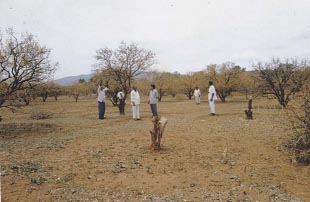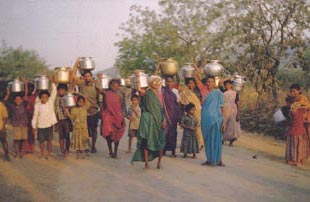

Case Study Area I: Andhra Pradesh in India
Andhra Pradesh covers an area of about 275,000 sq. km. It is the fifth largest state in India and the fourth most populous. Its population grew from 66.5 million in 1991 to over 75 million in 2001. Nearly three quarters of this population live in rural areas. Andhra Pradesh has 23 districts, each of which is divided into revenue mandals. Prakasam district, for example, has 56 mandals. Each mandal has around 20-35 revenue villages with Gram Panchayats (village governments). The state can be divided into three regions - Coastal Andhra, Ralayaseema and Telengana, each of which has a distinct history and social and cultural conditions.
The state is drained by three major perennial rivers: Godavari, Krishna and Pennar, as well as several other rivers of lesser significance. The majority of the rivers flow easterly towards the Bay of Bengal. The state has areas rich in water resources, but also has semi-arid regions where agriculture is mainly rainfed.
Andhra Pradesh falls under the semi-arid region of peninsular India and has a typical tropical climate: hot summers but relatively pleasant winters, especially in the plains of the interior. Four distinct climatic seasons can be distinguished:
Scattered rains from April onwards build into heavy showers in August, September and October, tapering off by December. The hot season starts from March, builds to a peak in June, and begins to taper off with the monsoon rains. Temperatures can rise above 40 degrees centigrade during the summer.
The gross state domestic product at constant 1993-94 prices for the year 2000-2001 is estimated to be Rs. 82434 crores (about US $ 18,320 million) with a growth rate of 5.15 per cent compared to the previous year. Although agriculture has historically been the main source of income and livelihoods, this is changing. The share of agriculture in the state's income has reduced from 59 percent to 34 percent between 1960 and 1999. Gains have been made by both the secondary sector (e.g., mining, manufacturing, construction and utilities) - from 12 to 23 percent - and the tertiary sector (services) - 29 to 44 percent.
As for employment generation Andhra Pradesh's economy continues to be predominantly agrarian. The share of state's rural labour force employed in agriculture (main workers only) was as high as 81 per cent in 1991. Nearly 59 per cent of the agricultural workers are labourers. Thus the crucial dependence of its rural labour force on agriculture is quite evident and is unlikely to diminish drastically in the near future.
With only about 46 per cent of the gross cropped area is under irrigation, agriculture in Andhra Pradesh is mostly dependent on rainfall. Success in agricultural production mostly depends upon the proper seasonal distribution of rainfall.
South-west and north-east Monsoons are the two important periodic winds which are the important sources of rain. The south-west monsoon is spread over the period commencing from June and ending with September and north-east monsoon from October to December. During the year The State received major portion of its rainfall from south-west Monsoon. During 2000-2001 the state received excess rainfall from the south-west monsoon (759 mm against the normal of 624 mm), but deficit rainfall from the north-east Monsoon (91 mm against a normal of 224 mm).
The Andhra Pradesh districts Anantapur, Chittoor, Cuddapah, Hyderabad, Kurnool, Mehaboobnagar, Nalgonda, and Prakasam are frequently affected by drought conditions due to deficit rainfall. During the year 2001, for example, Prakasam district (where the survey on drought conditions is carried out) received 56 per cent deficit rainfall during June and July. This led to a deficiency of over 83 per cent in crops sown during these months.
 |
 |
In addition to a loss of agricultural production the drought situation also leads to loss of livelihood for agricultural labourers, which often prompts them to migrate to other areas. Similarly, drought affects the fodder availability for animal husbandry, which in turn affects milk production. At the household level the impact of drought in these districts is felt through a shortage of drinking water. The local people, particularly women and children, have to walk several kilometres to fetch water in the neighbouring village.
A number of schemes executed by central and state governments are in place to safe-guard people against drought-induced impacts. Drought Prone Area Programme (DPAP) and the Desert Development Programme (DDP) are two such programmes in operation in Prakasam districts with central government assistance.
Back